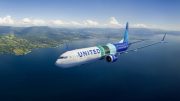Second Quarter 2023
- Transitioning 737 production to 38 per month; increased 787 production to four per month
- Revenue increased to $19.8 billion primarily reflecting 136 commercial deliveries
- Operating cash flow of $2.9 billion and free cash flow of $2.6 billion (non-GAAP); cash and marketable securities of $13.8 billion
- Total company backlog of $440 billion, including over 4,800 commercial airplanes
- Reaffirm guidance: $4.5-$6.5 billion of operating cash flow and $3.0-$5.0 billion of free cash flow (non-GAAP)
| Table 1. Summary Financial Results | Second Quarter | First Half | ||||||||||||||
| (Dollars in Millions, except per share data) | 2023 | 2022 | Change | 2023 | 2022 | Change | ||||||||||
| Revenues | $19,751 | $16,681 | 18 % | $37,672 | $30,672 | 23 % | ||||||||||
| GAAP | ||||||||||||||||
| (Loss)/earnings from operations | ($99) | $780 | NM | ($248) | ($382) | NM | ||||||||||
| Operating margins | (0.5) | % | 4.7 | % | NM | (0.7) | % | (1.2) | % | NM | ||||||
| Net (loss)/earnings | ($149) | $160 | NM | ($574) | ($1,082) | NM | ||||||||||
| (Loss)/earnings per share | ($0.25) | $0.32 | NM | ($0.93) | ($1.73) | NM | ||||||||||
| Operating cash flow | $2,875 | $81 | NM | $2,557 | ($3,135) | NM | ||||||||||
| Non-GAAP* | ||||||||||||||||
| Core operating (loss)/earnings | ($390) | $496 | NM | ($830) | ($949) | NM | ||||||||||
| Core operating margins | (2.0) | % | 3.0 | % | NM | (2.2) | % | (3.1) | % | NM | ||||||
| Core loss per share | ($0.82) | ($0.37) | NM | ($2.08) | ($3.11) | NM |
*Non-GAAP measure; complete definitions of Boeing’s non-GAAP measures are on page 5, “Non-GAAP Measures Disclosures.”
The Boeing Company [NYSE: BA] recorded second quarter revenue of $19.8 billion, GAAP loss per share of ($0.25) and core loss per share (non-GAAP)* of ($0.82) (Table 1). Second quarter results reflect higher commercial volume and lower defense margins. Boeing generated operating cash flow of $2.9 billion and free cash flow of $2.6 billion (non-GAAP).
“We had a solid second quarter with improved deliveries and strong free cash flow generation. We are well positioned to meet the operational and financial goals we set for this year and for the long term,” said Dave Calhoun, Boeing president and chief executive officer. “While we have more work ahead, we are making progress in our recovery and driving stability in our factories and the supply chain to meet our customer commitments. With demand strong, we’re steadily increasing our production rates across key programs and growing investments in our people, products and technologies.”
| Table 2. Cash Flow | Second Quarter | First Half | ||||||||||||||
| (Millions) | 2023 | 2022 | 2023 | 2022 | ||||||||||||
| Operating cash flow | $2,875 | $81 | $2,557 | ($3,135) | ||||||||||||
| Less additions to property, plant & equipment | ($296) | ($263) | ($764) | ($612) | ||||||||||||
| Free cash flow* | $2,579 | ($182) | $1,793 | ($3,747) |
*Non-GAAP measure; complete definitions of Boeing’s non-GAAP measures are on page 5, “Non-GAAP Measures Disclosures.”
Operating cash flow was $2.9 billion in the quarter reflecting higher commercial deliveries and favorable receipt timing (Table 2).
| Table 3. Cash, Marketable Securities and Debt Balances | Quarter End | |||||
| (Billions) | Q2 23 | Q1 23 | ||||
| Cash | $7.3 | $10.8 | ||||
| Marketable securities1 | $6.5 | $4.0 | ||||
| Total | $13.8 | $14.8 | ||||
| Consolidated debt | $52.3 | $55.4 |
1 Marketable securities consist primarily of time deposits due within one year classified as “short-term investments.”
Cash and investments in marketable securities totaled $13.8 billion, compared to $14.8 billion at the beginning of the quarter (Table 3). Debt was $52.3 billion, down from $55.4 billion at the beginning of the quarter due to the pay down of maturing debt. The company maintains access to credit facilities of $12.0 billion, which remain undrawn.
Total company backlog at quarter end was $440 billion.
Segment Results
Commercial Airplanes
| Table 4. Commercial Airplanes | Second Quarter | First Half | ||||||||||||||||||||||||||||||||||||
| (Dollars in Millions) | 2023 | 2022 | Change | 2023 | 2022 | Change | ||||||||||||||||||||||||||||||||
| Deliveries | 136 | 121 | 12 % | 266 | 216 | 23 % | ||||||||||||||||||||||||||||||||
| Revenues | $8,840 | $6,258 | 41 % | $15,544 | $10,452 | 49 % | ||||||||||||||||||||||||||||||||
| Loss from operations | ($383) | ($219) | NM | ($998) | ($1,116) | NM | ||||||||||||||||||||||||||||||||
| Operating margins | (4.3) | % | (3.5) | % | NM | (6.4) | % | (10.7) | % | NM |
Commercial Airplanes second quarter revenue increased to $8.8 billion driven by higher 787 deliveries (Table 4). Operating margin of (4.3) percent also reflects abnormal costs and period expenses, including research and development.
The 737 program is transitioning production to 38 per month and plans to reach 50 per month in the 2025/2026 timeframe. The program still expects to deliver 400-450 airplanes this year.
The 787 program increased production to four per month with plans to ramp to five per month in late 2023 and 10 per month in the 2025/2026 timeframe. The program still expects to deliver 70-80 airplanes this year.
During the quarter, Commercial Airplanes booked 460 net orders, including 220 for Air India and 39 for Riyadh Air, and secured a commitment from Ryanair for up to 300 737 MAX airplanes. Commercial Airplanes delivered 136 airplanes during the quarter and backlog included over 4,800 airplanes valued at $363 billion.
Defense, Space & Security
| Table 5. Defense, Space & Security | Second Quarter | First Half | ||||||||||||||||||||||||||||||||||||
| (Dollars in Millions) | 2023 | 2022 | Change | 2023 | 2022 | Change | ||||||||||||||||||||||||||||||||
| Revenues | $6,167 | $6,191 | — % | $12,706 | $11,674 | 9 % | ||||||||||||||||||||||||||||||||
| (Loss)/earnings from operations | ($527) | $71 | NM | ($739) | ($858) | NM | ||||||||||||||||||||||||||||||||
| Operating margins | (8.5) | % | 1.1 | % | NM | (5.8) | % | (7.3) | % | NM |
Defense, Space & Security second quarter revenue was $6.2 billion. Second quarter operating margin was (8.5) percent, primarily driven by losses on certain fixed-price development programs, as well as continued operational impacts of labor instability and supply chain disruption on other programs. The Commercial Crew program recorded a $257 million loss primarily due to the impacts of the previously announced launch delay. The T-7A program recorded a $189 million loss primarily due to higher estimated costs on production contracts. The MQ-25 program also recorded a $68 million loss primarily due to schedule delays on the Engineering and Manufacturing Development contract.
During the quarter, Defense, Space & Security completed the U.S. Air Force first flight of the T-7A Red Hawk, began construction on the Advanced Coatings Center in St. Louis and captured an award from the U.S. Army for 19 CH-47 Chinooks. Backlog at Defense, Space & Security was $58 billion, of which 31 percent represents orders from customers outside the U.S.
Global Services
| Table 6. Global Services | Second Quarter | First Half | ||||||||||||||||||||||||||||||||||||
| (Dollars in Millions) | 2023 | 2022 | Change | 2023 | 2022 | Change | ||||||||||||||||||||||||||||||||
| Revenues | $4,746 | $4,298 | 10 % | $9,466 | $8,612 | 10 % | ||||||||||||||||||||||||||||||||
| Earnings from operations | $856 | $728 | 18 % | $1,703 | $1,360 | 25 % | ||||||||||||||||||||||||||||||||
| Operating margins | 18.0 | % | 16.9 | % | 1.1 pts | 18.0 | % | 15.8 | % | 2.2 pts |
Global Services second quarter revenue of $4.7 billion and operating margin of 18.0 percent reflect higher commercial volume and favorable mix.
During the quarter, Global Services announced expansion in Poland with a new parts distribution site, collaboration with CAE to enhance and expand training solutions and Japan Airlines adopted Boeing Insight Accelerator for its 787 fleet.
Additional Financial Information
| Table 7. Additional Financial Information | Second Quarter | First Half | ||||||||||||||||||||||||
| (Dollars in Millions) | 2023 | 2022 | 2023 | 2022 | ||||||||||||||||||||||
| Revenues | ||||||||||||||||||||||||||
| Unallocated items, eliminations and other | ($2) | ($66) | ($44) | ($66) | ||||||||||||||||||||||
| Earnings/(loss) from operations | ||||||||||||||||||||||||||
| FAS/CAS service cost adjustment | $291 | $284 | $582 | $567 | ||||||||||||||||||||||
| Other unallocated items and eliminations | ($336) | ($84) | ($796) | ($335) | ||||||||||||||||||||||
| Other income, net | $320 | $253 | $622 | $434 | ||||||||||||||||||||||
| Interest and debt expense | ($621) | ($656) | ($1,270) | ($1,293) | ||||||||||||||||||||||
| Effective tax rate | 62.8 | % | 57.6 | % | 35.9 | % | 12.8 | % |
The increase in loss from Other unallocated items and eliminations was primarily driven by deferred compensation expense. Other income primarily reflects an increase in investment income due to higher interest rates. The second quarter effective tax rate primarily reflects the tax benefit on pre-tax losses including cumulative adjustments related to a projected increase in the valuation allowance.
Non-GAAP Measures Disclosures
We supplement the reporting of our financial information determined under Generally Accepted Accounting Principles in the United States of America (GAAP) with certain non-GAAP financial information. The non-GAAP financial information presented excludes certain significant items that may not be indicative of, or are unrelated to, results from our ongoing business operations. We believe that these non-GAAP measures provide investors with additional insight into the company’s ongoing business performance. These non-GAAP measures should not be considered in isolation or as a substitute for the related GAAP measures, and other companies may define such measures differently. We encourage investors to review our financial statements and publicly-filed reports in their entirety and not to rely on any single financial measure. The following definitions are provided:
Core Operating Earnings/(loss), Core Operating Margin and Core Earnings/(loss) Per Share
Core operating earnings/(loss) is defined as GAAP earnings from operations excluding the FAS/CAS service cost adjustment. The FAS/CAS service cost adjustment represents the difference between the Financial Accounting Standards (FAS) pension and postretirement service costs calculated under GAAP and costs allocated to the business segments. Core operating margin is defined as core operating earnings/(loss) expressed as a percentage of revenue. Core earnings/(loss) per share is defined as GAAP diluted earnings per share excluding the net earnings per share impact of the FAS/CAS service cost adjustment and Non-operating pension and postretirement expenses. Non-operating pension and postretirement expenses represent the components of net periodic benefit costs other than service cost. Pension costs allocated to BDS and BGS businesses supporting government customers are computed in accordance with U.S. Government Cost Accounting Standards (CAS), which employ different actuarial assumptions and accounting conventions than GAAP. CAS costs are allocable to government contracts. Other postretirement benefit costs are allocated to all business segments based on CAS, which is generally based on benefits paid. Management uses core operating earnings/(loss), core operating margin and core earnings/(loss) per share for purposes of evaluating and forecasting underlying business performance. Management believes these core measures provide investors additional insights into operational performance as they exclude non-service pension and post-retirement costs, which primarily represent costs driven by market factors and costs not allocable to government contracts. A reconciliation between the non-GAAP and GAAP measures is provided on page 12 and page 13.
Free Cash Flow
Free cash flow is GAAP operating cash flow reduced by capital expenditures for property, plant and equipment. Management believes free cash flow provides investors with an important perspective on the cash available for shareholders, debt repayment, and acquisitions after making the capital investments required to support ongoing business operations and long term value creation. Free cash flow does not represent the residual cash flow available for discretionary expenditures as it excludes certain mandatory expenditures such as repayment of maturing debt. Management uses free cash flow as a measure to assess both business performance and overall liquidity. See Table 2 on page 2 and page 14 for reconciliations of free cash flow to GAAP operating cash flow.
Caution Concerning Forward-Looking Statements
This press release contains “forward-looking statements” within the meaning of the Private Securities Litigation Reform Act of 1995. Words such as “may,” “should,” “expects,” “intends,” “projects,” “plans,” “believes,” “estimates,” “targets,” “anticipates,” and similar expressions generally identify these forward-looking statements. Examples of forward-looking statements include statements relating to our future financial condition and operating results, as well as any other statement that does not directly relate to any historical or current fact. Forward-looking statements are based on expectations and assumptions that we believe to be reasonable when made, but that may not prove to be accurate. These statements are not guarantees and are subject to risks, uncertainties, and changes in circumstances that are difficult to predict. Many factors could cause actual results to differ materially and adversely from these forward-looking statements. Among these factors are risks related to: (1) general conditions in the economy and our industry, including those due to regulatory changes; (2) our reliance on our commercial airline customers; (3) the overall health of our aircraft production system, planned commercial aircraft production rate changes, our ability to successfully develop and certify new aircraft or new derivative aircraft, and the ability of our aircraft to meet stringent performance and reliability standards; (4) changing budget and appropriation levels and acquisition priorities of the U.S. government, as well as the potential impact of a government shutdown; (5) our dependence on our subcontractors and suppliers, as well as the availability of highly skilled labor and raw materials; (6) competition within our markets; (7) our non-U.S. operations and sales to non-U.S. customers; (8) changes in accounting estimates; (9) realizing the anticipated benefits of mergers, acquisitions, joint ventures/strategic alliances or divestitures; (10) our dependence on U.S. government contracts; (11) our reliance on fixed-price contracts; (12) our reliance on cost-type contracts; (13) contracts that include in-orbit incentive payments; (14) unauthorized access to our, our customers’ and/or our suppliers’ information and systems; (15) potential business disruptions, including threats to physical security or our information technology systems, extreme weather (including effects of climate change) or other acts of nature, and pandemics or other public health crises; (16) potential adverse developments in new or pending litigation and/or government inquiries or investigations; (17) potential environmental liabilities; (18) effects of climate change and legal, regulatory or market responses to such change; (19) changes in our ability to obtain debt financing on commercially reasonable terms, at competitive rates and in sufficient amounts; (20) substantial pension and other postretirement benefit obligations; (21) the adequacy of our insurance coverage; (22) customer and aircraft concentration in our customer financing portfolio; and (23) work stoppages or other labor disruptions.
Additional information concerning these and other factors can be found in our filings with the Securities and Exchange Commission, including our most recent Annual Report on Form 10-K, Quarterly Reports on Form 10-Q and Current Reports on Form 8-K. Any forward-looking statement speaks only as of the date on which it is made, and we assume no obligation to update or revise any forward-looking statement, whether as a result of new information, future events, or otherwise, except as required by law.
Source : Boeing













Be the first to comment on "Boeing Reports Second Quarter Results"